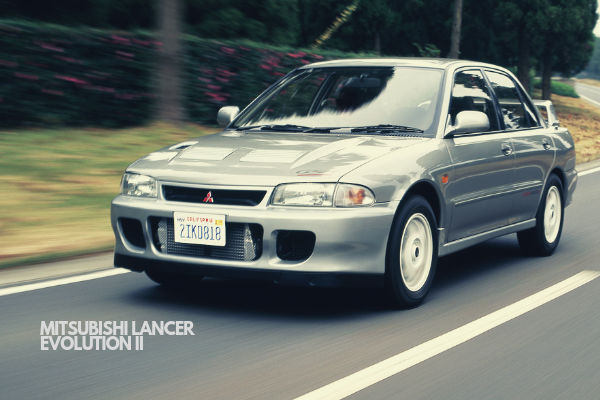In this review...
- 1. Introduction
- 2. The era of rally domination
- 3. The Evo takes the world stage by storm
- 4. Mitsubishi Lancer Evolution: What now?
1. Introduction
The Mitsubishi Lancer Evolution (or simply Evo) is one of the most iconic cars in history - a culmination of decades of research and development. It’s definitely Mitsubishi’s halo car.
The Lancer was introduced in 1973 as a small, fuel-efficient family car. During this time, though Mitsubishi wanted to improve its motorsport image and set its sights on rallying to showcase the company’s technical know-how. Fitting the little Mitsubishi Lancer with a bigger engine, they called it the 1600GSR.
This became the entry point for Mitsubishi becoming one of the most iconic brands in rally racing. The Mitsubishi Lancer 1600GSR won the 1974 East African Safari Rally and marked the beginning of Mitsubishi’s rallying dominance.

The 1600 GSR is one of the most iconic models in Rally Racing
By the late ‘80s, Mitsubishi wanted to move on to bigger competitions by joining the now-infamous Group B Rally Racing series with their Mitsubishi Starion Prototype. But before final development, Group B was banned by the FIA for repeated accidents on the track causing death of both drivers and spectators.
Mitsubishi had no choice but to drop development for the race-ready Starion and follow through with the new Mitsubishi Galant VR-4 for Group A Racing instead. Let's go back in time with Philkotse.com right now!
2. The era of rally domination
1987 Mitsubishi Galant VR-4
The Mitsubishi Lancer Evolution can trace its roots to the legendary Mitsubishi Galant VR-4. A 2.0-liter, turbocharged, four-cylinder engine it directs power to all four wheels creating the template for all Lancer Evolutions to come. Since homologation requires a certain number of cars be sold for a model to compete in Group A, Mitsubishi released the Galant VR-4 to the public.
It was a slightly watered-down version creating 195hp. Only a few thousand models were sold around the world, making the VR-4 rare and valuable as it is powerful.

The Galant VR-4 is the template for all Lancer Evolutions to come
The Evo’s heart
One thing in common among all the Evos (except the last one) is the engine. For decades, the vaunted Mitsubishi 4G63T engine powered everything from the Galant VR-4 to the Lancer Evolution from the first to the penultimate ninth generation.
Its rugged cast-iron engine block gave it strength to withstand massive amounts of boost from the huge turbocharger and high revving during competition scenarios. The engine was so good that much of it remained unchanged for years to come until the 10th-gen Evo.

The 4G63T Powered all Evos except the Final one
Mitsubishi Lancer Evolution I
European rally stages during the late ‘80s and early ‘90s suddenly got too tight for a big fat sedan such as the Mitsubishi Lancer VR-4. A number of manufacturers joining the race transitioned to smaller and more agile platforms. Ford moved from the Sierra to the Escort, Subaru from the Legacy to the Impreza. Mitsubishi felt the need to move on from the Galant’s body to the Lancer.

Only 5000 models were built and it was sold out in Japan in record time
Mitsubishi crammed the entire drivetrain and engine of the Galant into the tiny Lancer body. With the 4G63T creating more or less 247hp paired to a lighter Lancer body, Mitsubishi was able to hang with the big boys during rally racing.
The Lancer Evolution I was offered in two trims, the GSR, offering the same performance and looks of the original rally car, and the crazy RS model which is stripped down of all creature comforts such as power windows, door locks, and even anti-lock brakes in order to save on more than a hundred pounds of weight compared to the GSR model. Only 5,000 models were built and they were sold out in Japan in record time.
>>> Have you known the Mitsubishi Lancer Evolution is rumored to return?
Mitsubishi Lancer Evolution II
The dawn of the much-anticipated Lancer Evolution II happened in 1993. This model only introduced very minor changes compared to the Evo I. It offered a wider track and longer wheelbase, larger tires on the same 15-inch mag wheels, stiffer sway bars, and a larger rear wing that with handling.
The engine was also tweaked to produce 256hp, almost 10 more than the previous model. People considered Evolution II as more of the same car from the Evolution I with just a few performance improvements.

This model only introduced very minor changes compared to the Evo I
Mitsubishi Lancer Evolution III
Despite all the power from the first two Evos, Subaru was still beating Mitsubishi with the Impreza -- along with the iconic driver Colin McRae. In 1995, this all changed with the introduction of the Lancer Evolution III. Built from the same Lancer platform, the Evo III this time had a bigger aero body kit to help with aerodynamics.
The engine also produced even more power (266hp) from before, through a higher compression ratio. More importantly, Mitsubishi finally stood a chance at the World Rally Championship thanks to their own legendary driver, Tommi Makinen.

The Evo III this time had bigger aero body kits to help with aerodynamics
Mitsubishi Lancer Evolution IV
Tommi Makinen brought the Lancer Evolution’s popularity to new heights because of his various rally wins in the Evo III. Because of this, the popularity of the Evo now reached far beyond Japan. The new Lancer Evolution IV was then based on the new Lancer platform -- bigger and lighter with a more rigid body frame and chassis compared to the other Mitsubishi models.
It also had an all-new twin-scroll turbo for more power, and an active yaw control system that regulated power and torque that went to each individual wheel. It also introduced the now-iconic two round fog lamps to emphasize its rally heritage.

The popularity of the Evo has now reached far beyond Japanese shores
In 1997, the Lancer Evolution III and IV were introduced in one of the most influential driving video games of all time, a game called Gran Turismo for the Playstation.
Mitsubishi Lancer Evolution V and VI
The Lancer Evolution V and VI were pretty much the same vehicles as the Evolution IV with simple performance upgrades and visual tweaks. These models introduced a larger track, and the chassis was extended to accommodate the larger 17-inch wheels and tires.
There also was a “gentleman’s agreement” among Japanese manufacturers to never surpass an agreed-upon arbitrary number in terms of horsepower. Because of this, the 4G63T engine kept an output of 276hp. It was an open secret though that Mitsubishi’s monster engine had already surpassed this number -- and then some.

The 4G63T engine was kept at an output of 276hp
In tribute to Tommi Makinen, Mitsubishi also released a Tommi Makinen version for the Lancer Evolution VI. These versions featured upgraded aero body kits, Recaro seats, and special badging and decals around the car to commemorate and replicate Makinen’s Lancer Evolution Rally car. The Tommi Makinen version was designed so differently from the original RS and GSR that people often referred to it as the Lancer Evolution 6.5.

Mitsubishi also released a Tommi Makinen version for the Lancer Evolution VI
Thus concludes the first part of our journey through the history of the Lancer Evolution. Please read on for part 2 where the Lancer Evolution takes the world by storm.
3. The Evo takes the world stage by storm
Mitsubishi Lancer Evolution VII
In 2001, the Lancer Evolution moved to the new Lancer Cedia platform. Cedia stands for “century diamond” to commemorate the new century and Mitsubishi’s stride to further itself as a car company. The Cedia platform featured a new and slightly heavier chassis from the models it replaced. It introduced a host of suspension upgrades and engine tweaks.

The Cedia platform featured a new and slightly heavier chassis
Apart from active yaw control and upgraded twin-scroll turbos, the Lancer Evolution VII also introduced an active center differential system allowing the Evo to intelligently send power to all four wheels depending on the situation and need. It may look like a normal Lancer but thanks to the genius of center differential, suspension tweaks, and huge Brembo Brakes, this is every inch an Evo -- and maybe even more.
Mitsubishi Lancer Evolution VIII
The Lancer Evolution was introduced officially into the US Market in 2003 through the Los Angeles Auto Show. The Evo VIII was lighter than the previous model and featured all-new Bilstein Suspension, Enkei wheels, and improved Brembo brakes. The Evo VIII adapted well to the US Market.
The model lacked the active yaw control present in the international version, but potential buyers didn’t care and were simply thankful that Mitsubishi finally blessed the US market with the Lancer Evolution.

2003 Finally saw the Lancer Evolution being introduced officially into the US Market
Power was still stuck at the supposed gentleman’s agreement -- officially producing 271hp from the same two-liter 4G63T engine. Though a much lower figure than its rival, the Subaru WRX STI, the Lancer Evolution VIII was still able to handily defeat its compatriot.
A special-edition FQ-400 version was also introduced that year, which created an insane 400hp at 6,400rpm. It was able to reach 100kph from a standing start in just 3.5 seconds. You might probably recognize the FQ-400 Evolution VIII giving a Lamborghini Murcielago the business on a TopGear Test Track. During the broadcast, they featured the Lancer Evolution VIII catching up to a legitimate supercar.
Mitsubishi Lancer Evolution IX
In 2005, Mitsubishi Introduced the Lancer Evolution XI too much fanfare at the New York Auto Show. It had revised front and rear bumpers and an improved body kit to further aid aerodynamics. Some people would often dismiss the Evolution IX as merely an updated Evo VIII but the most important development for the car was not its looks but with the engine.

Introduced revised front and rear bumpers and an improved body kit
In its final iteration, the 4G63T now had MIVEC technology which is Mitsubishi’s version of variable valve timing -- increasing performance efficiency and marking significant improvements to the Lancer’s fuel consumption. It also had a new twin-scroll turbocharger, paired to a new limited-slip differential. It served up 287hp and 400Nm.

The Station Wagon Version was a swan song for the 4G63T engine
The Lancer Evolution IX also introduced to the world the Evolution Station Wagon. This is the most sought-after model as only 2,500 models were released. It featured the same mechanicals as the regular Lancer Evolution IX but had a huge wagon rear to store all your knick-knacks and grocery items.
It also didn’t weigh more than the regular Evolution IX sedan. The surplus of 44kg was only due to structural rigidity contingencies to mitigate for the fact that this was a station wagon with a huge hatch in the back and was able to fold its seats flat. The Lancer Evolution IX Station wagon was a harbinger of things to come for Mitsubishi, serving as a swan song for the vaunted 4G63T engine.
Mitsubishi Lancer Evolution X
While everyone was enjoying the Lancer Evolution IX in 2005, waxing poetic for another job well-done by Mitsubishi, the car brand was not resting on its laurels. Its designers were already busy developing the next-gen Lancer Evolution, codenamed: Concept-X.
It was designed in Mitsubishi’s European design center and was to be the Evolution’s first all-new change ever since the first car. It was then unveiled as a prototype at the North American International Auto Show and finally released in 2008.

Developing the Next-Gen Evo from the ground up
The Lancer Evolution X dropped the 4G63T engine in favor of the new 4B11T which is an all-aluminum engine producing 295hp. The Lancer Evolution X featured an all-new semi-sequential twin-clutch transmission system that was controlled using magnesium alloy paddle shifters mounted on the steering column.
For a brief time in 2008, the Philippines introduced a local-spec model which was based on US trims. Five variants were made available here; the GSR which features a five-speed manual transmission, and the MR featuring a six-speed TC-SST gearbox.
2015 Mitsubishi Lancer Evolution: Final Edition
Unfortunately, in 2015 and 2016, Mitsubishi ended the run of the Evos. This was the year when the Evolution X Final Edition has released with1,000 models released in its home market, 350 in Canada, 150 in Australia, and another 1,600 in the US.
Mitsubishi reiterated that its focus would be shifted from performance vehicles such as the Lancer Evolution to electric vehicles. There have been rumors though that Mitsubishi had this plan in the pipeline because of financial problems. We wouldn’t know now for sure. All we know is that the Lancer Evolution 2015 was the last of the Evos.

Mitsubishi was to focus more on EV development
4. Mitsubishi Lancer Evolution: What now?
There have been some rumors about the Lancer Evolution’s return recently. This is in conjunction with the Mitsubishi-Renault-Nissan alliance. The news is coming from unnamed sources within the company, and unsubstantiated news from all over the internet, so we can probably take this with a good amount of salt.
The closest thing Mitsubishi can come up with from this alliance and base their new Evolution on is the Renault Megane RS Trophy Edition.

Mitsubishi had to let go of their project car to focus more on practical matters
The Lancer Evolution is symbolic of our aspirations with our own personal cars, as this model itself is Mitsubishi’s project car. That despite all their financial problems, they sought to make their passion project their project car a little better every single year. They didn’t care if Subaru had more money or resources to do research on their own car. The Lancer was theirs and it was theirs to make better.
Much to everyone’s dismay, Mitsubishi had to let go of their project car to focus more on practical matters. Just like us in real life. Here’s hoping that Mitsubishi does find a way to get a hold of their finances, even it means getting help from Renault or Nissan to finally pick up their tools and get working on a new Evolution.
I suddenly feel that the world will become a much better place knowing there’s one Mitsubishi Lancer Evolution out there, doing 4-wheel skids. Hissing along with its turbo.
>>> Have yourself a Lancer Evolution right now by visiting Mitsubishi dealerships.

The Lancer was theirs and it was theirs to make better
Make sure to follow Philkotse.com for on more developments as this breaking news unfolds. Ready to build your own project car? Visit our cars for sale section to find the best deal from the most reputable dealers around town. Whether you’re looking for a used or brand new car, you know Philkotse.com has your back!
Recommended articles
- Mitsubishi Philippines price List 2025 Aug 01, 2020
- [PIMS 2018 - Part 2] Mitsubishi: All eyes are on the prototype e-Evolution concept car Oct 06, 2020
- Future Mitsubishi Lancer might come as a crossover Jun 07, 2021
- Mitsubishi e-Evolution Concept launched at Tokyo Motor Show 2017 Oct 06, 2020
- Mitsubishi Lancer EX: Comfortable, useful and active to drive Mar 06, 2021





















